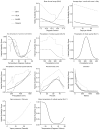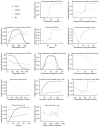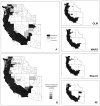Modeling the Geographic Distribution of Ixodes scapularis and Ixodes pacificus (Acari: Ixodidae) in the Contiguous United States
- PMID: 27282813
- PMCID: PMC5491370
- DOI: 10.1093/jme/tjw076
Modeling the Geographic Distribution of Ixodes scapularis and Ixodes pacificus (Acari: Ixodidae) in the Contiguous United States
Abstract
In addition to serving as vectors of several other human pathogens, the black-legged tick, Ixodes scapularis Say, and western black-legged tick, Ixodes pacificus Cooley and Kohls, are the primary vectors of the spirochete (Borrelia burgdorferi) that causes Lyme disease, the most common vector-borne disease in the United States. Over the past two decades, the geographic range of I. pacificus has changed modestly while, in contrast, the I. scapularis range has expanded substantially, which likely contributes to the concurrent expansion in the distribution of human Lyme disease cases in the Northeastern, North-Central and Mid-Atlantic states. Identifying counties that contain suitable habitat for these ticks that have not yet reported established vector populations can aid in targeting limited vector surveillance resources to areas where tick invasion and potential human risk are likely to occur. We used county-level vector distribution information and ensemble modeling to map the potential distribution of I. scapularis and I. pacificus in the contiguous United States as a function of climate, elevation, and forest cover. Results show that I. pacificus is currently present within much of the range classified by our model as suitable for establishment. In contrast, environmental conditions are suitable for I. scapularis to continue expanding its range into northwestern Minnesota, central and northern Michigan, within the Ohio River Valley, and inland from the southeastern and Gulf coasts. Overall, our ensemble models show suitable habitat for I. scapularis in 441 eastern counties and for I. pacificus in 11 western counties where surveillance records have not yet supported classification of the counties as established.
Keywords: Ixodes pacificus; Ixodes scapularis; Lyme disease; bioclimatic modeling; habitat suitability.
Published by Oxford University Press on behalf of Entomological Society of America 2016. This work is written by US Government employees and is in the public domain in the United States.
Figures





Comment in
-
The Leading Edge of the Geographic Distribution of Ixodes scapularis (Acari: Ixodidae).J Med Entomol. 2017 Sep 1;54(5):1103. doi: 10.1093/jme/tjx097. J Med Entomol. 2017. PMID: 28637325 No abstract available.
-
Response: The Geographic Distribution of Ixodes scapularis (Acari: Ixodidae) Revisited: The Importance of Assumptions About Error Balance.J Med Entomol. 2017 Sep 1;54(5):1104-1106. doi: 10.1093/jme/tjx096. J Med Entomol. 2017. PMID: 28874013 Free PMC article. No abstract available.
References
-
- Araujo M, New M. Ensemble forecasting of species distributions. Trends Ecol Evol. 2007;22:42–47. - PubMed
-
- Balashov Y. Blood sucking ticks (Ixodoidea): Vectors of diseases of man and animals. University of Michigan, MI: 1971.
-
- Bertrand MR, Wilson ML. Microclimate-dependent survival of unfed adult Ixodes scapularis (Acari: Ixodidae) in nature: Life cycle and study design implications. Entomol Soc Am. 1996;33:619–627. - PubMed
-
- Brinkerhoff RJ, Folsom-O'Keefe CM, Tsao K, Diuk-Wasser MA. Do birds affect Lyme disease risk? Range expansion of the vector-borne pathogen Borrelia burgdorferi. Front Ecol Environ. 2011;9:103–110.
Grants and funding
LinkOut - more resources
Full Text Sources
Other Literature Sources
Miscellaneous

